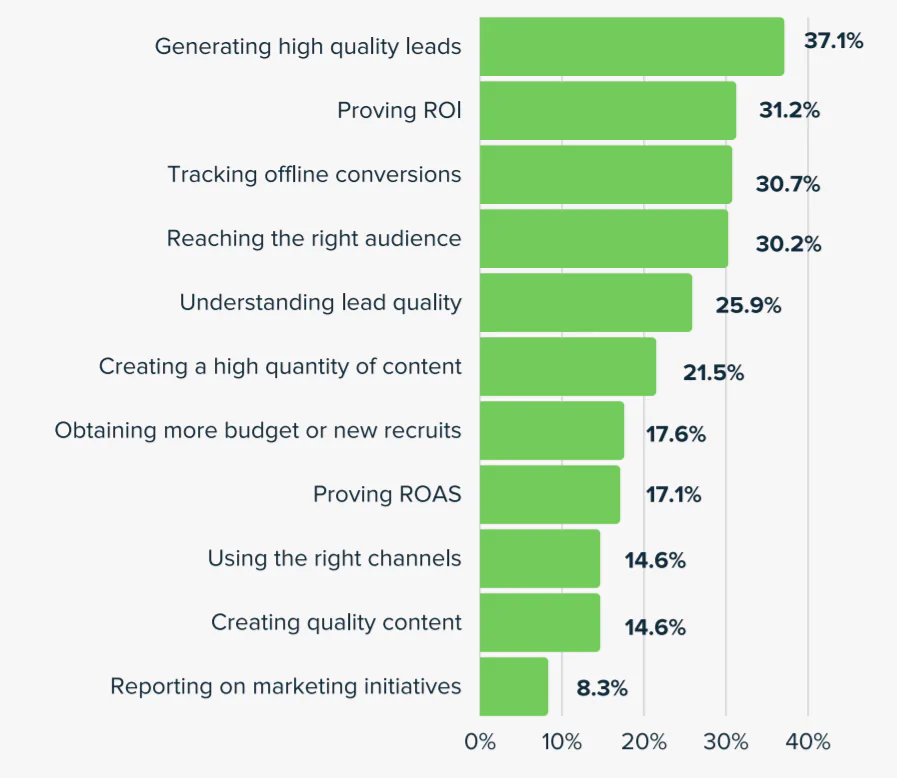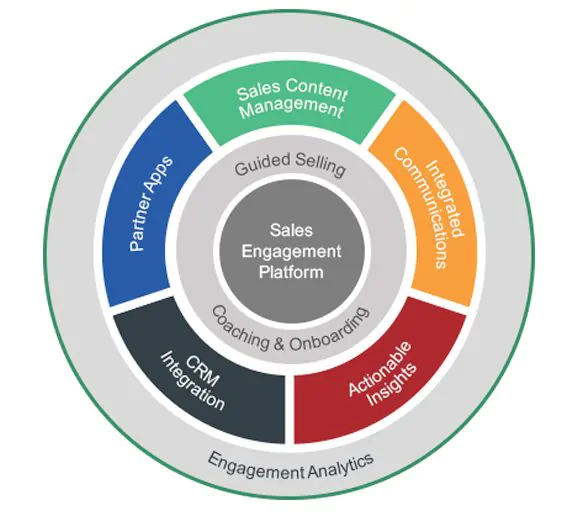Thanks to the digital revolution, businesses can access more customers instantly than they ever could before. However, this ability to connect with the entire world through digital tools has brought about its own series of challenges. Finding good leads in today’s massive digital market can sometimes feel like searching for a needle in the “internet haystack.”
It’s no surprise that lead generation is listed as the marketing team’s top priority nine times out of ten. But you may be surprised to know just how many of even the most talented marketers struggle to find qualified leads. According to Ruler Analytics’ Marketing Attribution and Reporting Analysis study, 37% of marketing teams agreed that generating quality leads was the biggest challenge they faced.

Source: Ruler Analytics
But it’s not just finding leads that’s difficult; it’s also keeping up with qualifying and nurturing strategies, keeping tabs on leads, and following up as they move through the sales funnel. Plus, there is the challenge of maintaining a consistent brand experience with every single lead.
Thankfully, with digital challenges come digital solutions. Sales Engagement Platforms (SEPs) are designed to fill the gap by providing marketers with a localized system to generate, nurture, and manage leads.
The results from SEPs are truly astounding. One survey concluded that businesses utilizing these platforms reported a 329% ROI within just three years of using them. SEPs are designed to make the lead generation challenge easier – but can they really deliver the results you want?
Key Takeaways:
- A sales engagement platform gives you a bird’s eye view of all customer interactions and lets you derive sales insights from any or all of them.
- SEPs results help you generate more and better-qualified leads.
- SEPs also make lead nurturing easier by integrating with your CRM and communication apps. They unify data from these disparate apps and allow you to pinpoint the factors that contributed most to the outcome.
What is a Sales Engagement Platform?
First, let’s get clear on what a sales engagement platform is – and what it is not. A SEP is a unified set of tools that help you plan, manage, track, and optimize customer interactions across multiple touches and channels via a single UI and dashboard.
That’s a lot. Read that again!
A SEP is different from a traditional marketing platform such as a CRM. A SEP often works in conjunction with CRMs, but its specific purpose is to automate the lead generation process.
Essentially, a SEP creates a unified database of all customer interactions – even if the action was generated outside of the program. For instance, it will mark what email correspondence has been sent, any information gathered, and all customer behavior data.
Source: ClearSlide
SEPs are designed to significantly increase outreach volume, so teams can reach far more initial leads. These platforms are also designed to integrate with the entire sales and marketing stack to support visibility across the organization.
The Real Benefits of Sales Engagement Platforms
A SEP should streamline and support an overall sales and marketing strategy. When used consistently, it will ensure that every customer goes through the steps of communication and nurturing, all while preventing leads from falling through the cracks.
But there are far more benefits than simply increased sales and conversions. First, it creates a vast database of robust customer data which can be used for all types of strategies. SEPs operate on KPIs, such as consumer response and behavior. This information can then be used to improve personalization, for market research purposes, or even to improve customer service interactions.
SEPs also make marketing automation a reality without overcomplicating the transition process. Virtually all digital communication and correspondence can be scheduled ahead of time and automated for consistent experiences. This also gives marketing teams the ability to create highly personalized strategies that will get adjusted based on set factors, like response times or lead source.
Now, if using a SEP can make such a dramatic difference in a few simple steps, why isn’t every single company utilizing one? The issue is that there are so many shoddy platforms on the market that actually stifle potential and even slow down the sales cycle.
These SEPs tend to over-promise and under-deliver big time. They focus primarily on all the unnecessary bells and whistles, leaving marketers totally confused when it comes to actually using the tool. Poor user interfaces also lead to major lead generation issues, such as over or under-nurturing, a lack of integration with other tools, and internal miscommunication.
How to Choose the Right Sales Engagement Platform for Your Business
Choosing the right SEP becomes even more complicated in the case of multi-location businesses that have a distributed sales team or a franchise network. In these cases, passing leads from Marketing to Sales is never a simple task – Sales needs them to be qualified according to location-specific criteria while Marketing needs visibility right up to the outcome. Overall, you need closed-loop accountability.
Thus, your business needs to get to the root of its current lead generation struggles and find a platform that addresses them to a large extent.
For instance, does your team find it nearly impossible to keep track of which team has contacted leads or where they fall in the sales funnel? Then, you need to use a SEP that specializes in lead management to compile all of your data into one platform that is easy to navigate. Additionally, a good SEP should also integrate seamlessly with all other marketing tools, such as Google Analytics, Zapier, invoicing software, project management software, email automation tool, and even Facebook.
One of the key capabilities a SEP needs is automation. More than three-quarters of marketing teams that use tools to automate generation strategies report significantly higher lead numbers. Without automation, your team will have a difficult time managing large numbers of leads.
As with all tools and software today, AI can prove to be a valuable addition here as well. Go with a smart system that utilizes AI for predictive analysis and personalization that actually makes a difference in your business.
Finally, a good SEP should have data analysis capabilities built right in. This is often where most marketers fall off. 25% of marketers admitted not knowing how to accurately report the impact of their lead generation campaigns. A great SEP system should automatically record KPIs and generate analysis reports for easily trackable results.
Take with a Dose of Sales-Marketing Alignment
Finding a SEP that’s a true match for your business is what will deliver true results. A sales engagement platform can be extremely powerful – but only if you have great sales-marketing alignment in place.
MXTR is designed to break the mold from traditional SEP design with the most important tools and features that are still easy to use. Our program is built to provide a consistent brand experience that effectively segments high-volume leads at the central level, nurtures them at the endpoints and network locations, and ties engagement at various touchpoints with the end result.
If you want marketing to generate more qualified leads and gain full visibility into how your prospects engage with your sales teams, click here to schedule a demo of MXTR right away.
Featured image: Pixabay






